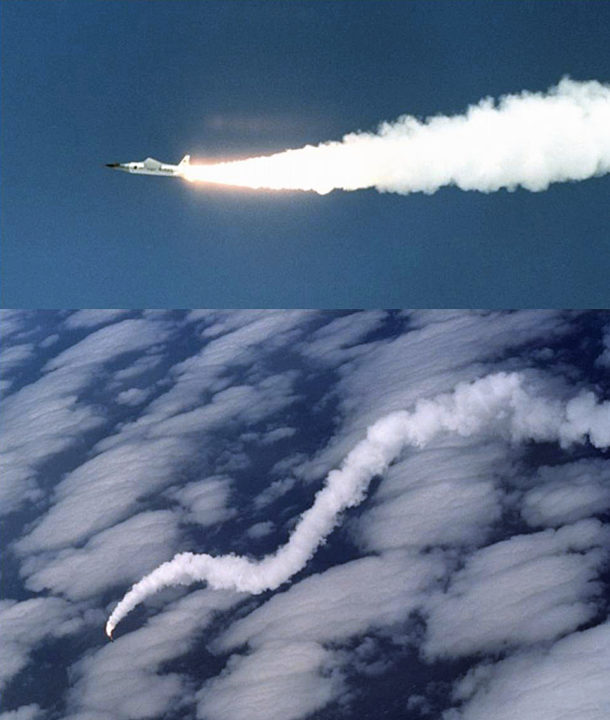
Nineteen years ago today, the first NASA X-43A airframe-integrated scramjet flight research vehicle was launched from a B-52 carrier aircraft high over the Pacific Ocean. The inaugural mission of the HYPER-X Flight Project came to an abrupt end when the launch vehicle departed controlled flight while passing through Mach 1.
In 1996, NASA initiated a technology demonstration program known as HYPER-X (HX). The central goal of the HYPER-X Program was to successfully demonstrate sustained supersonic combustion and thrust production of a flight-scale scramjet (Supersonic Combustion RAMJET) propulsion system at speeds up to Mach 10.
Also known as the HYPER-X Research Vehicle (HXRV), the X-43A aircraft was a scramjet test bed. The aircraft measured 12 feet in length, 5 feet in width, and weighed close to 3,000 pounds. The X-43A was boosted to scramjet take-over speeds with a modified Orbital Sciences Pegasus rocket booster.
The combined HXRV-Pegasus stack was referred to as the HYPER-X Launch Vehicle (HXLV). Measuring approximately 50 feet in length, the HXLV weighed slightly more than 41,000 pounds. The HXLV was air-launched from a B-52 mothership. Together, the entire assemblage constituted a 3-stage vehicle.
The first flight of the HYPER-X program took place on Saturday, 02 June 2001. The flight originated from Edwards Air Force Base, California. Using Runway 04, NASA’s venerable B-52B (S/N 52-0008) started its take-off roll at approximately 19:28 UTC. The aircraft then headed for the Pacific Ocean launch point located just west of San Nicholas Island.
At 20:43 UTC, the HXLV fell away from the B-52B mothership at 24,000 feet. Following a 5.2 second free fall, the rocket motor lit and the HXLV started to head upstairs. Disaster struck just as the vehicle accelerated through Mach 1. That’s when the rudder locked-up. The launch vehicle then pitched, yawed and rolled wildly as it departed controlled flight. Control surfaces were shed and the wing was ripped away. The HXRV was torn from the booster and tumbled away in a lifeless state. All airframe debris fell into the cold Pacific Ocean far below.
The mishap investigation board concluded that no single factor or so-called “smoking gun” cause was responsible for the loss of HX Flight No. 1. Failure occurred because the vehicle’s flight control system design was deficient in a number of simulation modeling areas. The result was that system operating margins were overestimated. Modeling inaccuracies were identified primarily in the areas of fin system actuation, vehicle aerodynamics, mass properties and parameter uncertainties. The flight mishap could only be reproduced when all of the modeling inaccuracies with uncertainty variations were incorporated in the analysis.
The X-43A Return-to-Flight effort took almost 3 years. Happily, the HYPER-X Program hit pay dirt twice in 2004. On Saturday, 27 March 2004, HX Flight No. 2 achieved scramjet operation at Mach 6.83 (almost 5,000 mph). This historic accomplishment was eclipsed by even greater success on Tuesday, 16 November 2004. Indeed, HX Flight No. 3 achieved sustained scramjet operation at Mach 9.68 (nearly 7,000 mph).
The historic achievements of the HYPER-X Program went largely unnoticed by the aerospace industry and the general public. For its part, NASA did not do a very good job of helping people understand the immensity of what was accomplished. Even the NASA Administrator appeared indifferent to the pioneering scramjet program. While he attended an X-Prize flight by Scaled-Composites’ SpaceShipOne right up the street at the Mojave Spaceport, he did not see fit to attend either of that year’s history-making scramjet flights that originated right down the road at Edwards Air Force base.
However, it was the loss of the Space Shuttle Columbia on STS-107 in February of 2003 that doomed HX even before the program’s first successful flight. Everything changed for NASA when Columbia and her crew was lost. The space agency’s overriding focus and meager financial resources went into the Shuttle Return-to-Flight and Phase-Out efforts. NASA’s aeronautical and access-to-space arms were especially hard hit.
If timing is everything as some insist, then the HYPER-X Program was really the victim of bad timing. It is both intriguing and distressing to ponder what would have been the case if HX Flight No. 1 had been successful. The likely answer is that at least one of the anticipated follow-on scramjet flight research programs (i.e., X-43B, X-43C, and X-43D) would have been developed and flown. Thanks to Murphy’s ubiquitous influence, we’ll never know.


Comments
Great article Terry! I remember all of this unfolding while I was working at my first professional job in the Air Force.
Share this post: